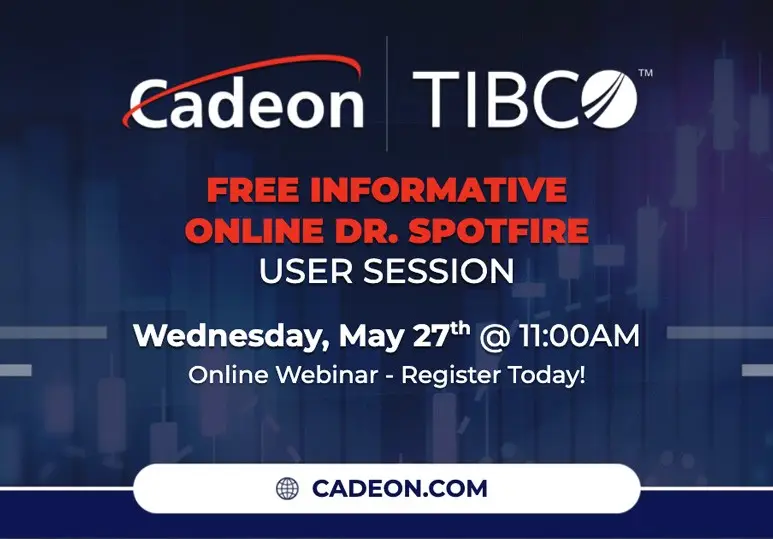Gaining A Competitive Advantage With Next-Gen Data Virtualization
Thank you to TIBCO for hosting a webinar with Cadeon and for extending the invitation to your community of amazing companies and individuals. It was an informative and valuable virtual session that covered the overview of data virtualization for businesses. Watch the video recap to learn more!
Are you looking to organize the jungle of data sources that your business produces? Are you ready to accelerate and optimize workflows for all users while keeping up with data security and privacy compliance? Read below for a summary of the webinar from July 20th where Mark Pietz – Senior Product Manager of TIBCO, Phil Unger – CEO and President of TIBCO, and Shane Griffin – CEO of Pillar 9 Technologies discussed the benefits of TIBCO Data Virtualization!
TIBCO Data Virtualization Provides Agile Data Provisioning With Data Integration Software
In our current digital age, organizations are becoming never-ending fountains for digital information. The problem with producing so much dataTIBCO amalgamates information from multiple different data sources e’re excited to announce that Cadeon and Tibco’s FREE Online SpotFire Webinar event is approaching! This Webinar event will feature important updates from Cadeon and TIBCO, and a special customer spotlight, Aaron Hugen. During this event, he will share his secrets of how to take full advantage of SpotFire’s GIS and data visualization capabilities to streamline business practices, specifically in energy acquisitions and divestitures.
Data virtualization is the process of discovering and actioning business insights from integrated and accessible data without being held back by complicated systems nor incompatible file formats.
Data virtualization can help your business thrive in today’s digital age because it allows for:
- Streamlined processes to reduce costs.
- Rapid decision-making with current data insights.
- Optimal digital storage by consolidating and reducing replicates.
How TIBCO Data Virtualization Creates, Distributes, Transforms, and Protects Data Views In Four Steps: (starts at 6:31)
Step One: Access Any Data Source. TIBCO Data Virtualization (TDV) doesn’t import nor move data into a separate system by holding files in a sandbox. Instead, TDV creates a live connection in real-time and TDV makes SQL queries down to the data source to create an independently manipulatable, but cleanly separated, data view. These virtual connections introspect the data to build up new views across various data sets.
Step Two: Combine & Transform. With new custom views of the data sets, TDV can further combine data from multiple sources, sort, transform, and filter data sets while the original raw data remains intact and untouched in your secure data storage origin.
Step Three: Optimize & Cache. When working with combined views and there are issues with performance due to data volumes or network latency problems, that’s why any SQL queries used to transform data views are cached and held at the computer where the data views are created for optimal performance. Also, if changes to a data set are routine (daily, weekly, monthly, etc.) a cache can be composed of historical data view settings for easier viewing.
Step Four: Deliver data. TDV serves as one centralized source of data across various teams. Views and data records can be are delivered in accordance with your custom data governance, information security, and privacy policies. Security layers are available within organizations, or between users (or both) to fit with your organization’s preferences.
4 Rapidly Emerging TIBCO Data Virtualization Use Cases (starts at 14:42)
Use Case #1: Logical Data Warehouse. Combine and provision all the enterprise data your business requires:
- Integrate multiple data sources as one virtual logical source for consumers with semantic consistency
- Decrease data duplication & hide the complexity resulting from different technologies, formats, protocols, locations, etc.
- Support self-service for users to access the data sources they need while still in compliance with governance and security best practices.
Use Case #2: Data Integration. Connect disjointed & diverse data across hybrid environments.
- Hide data complexity by making all your data sources (on premise or in cloud) easier to access, understand, and use compliantly.
- Empower business users and streamline workflows with regulated self-service capabilities so users can integrate data on their own.
- Respond faster to urgent data requirements with less data engineering effort and lower infrastructure costs.
- Comply with mandatory regulations through embedded security, governance, and quality compatibilities.
Use Case #3: Cloud Data Migration. Move data between supports systems, whether they’re on-premise or stored in a cloud system.
- Reduce time, cost, and risk of your enterprise data migration projects.
- Accelerate the migration of your largest datasets.
- Shield data locations from your users during information migration.
- Adopt new modern data architecture with the flexibility to maintain your existing systems.
Use Case #4: Data Fabric. Optimize data management and integration capabilities.
- Share data assets that support all your diverse user groups and specific use cases.
- Easily deploy and adopt a distributed data architecture that fits your complex, ever-changing technology landscape.
- Intelligently simplify, automate, and accelerate your data pipelines and workflows.
- Accelerate time to value (TTV) by unlocking and extracting valuable data insights regardless if they’re stored on premise or in a cloud database.
Deliver Data Wherever It's Needed At The Pace Of Business With TIBCO Data Virtualization (starts at 20:02)
Capability #1 Data Views. Create business-friendly data views by combining insight from multiple data sources.
- Conform to your business definitions enterprise data model and industry standards.
- Expose views in SQL, JDBC, ODBC. Or, as a web service with REST, SOAP, JSON, ODATA.
Capability #2 Streaming Data Virtualization. Extend data virtualization to various live data sources.
- Combine data in motion with data at rest.
- Connect to streaming sources such as JMS, OSIPI, Bloomberg, Twitter, GPS and more!
- Solve Internet of Things (IoT) use cases that require connectivity and data analytics.
- Augment internal data with external sources for rich contextual information.
Capability #3 Web User Interface (UI). Self-service data preparation and transformation.
- Designed for citizen data engineers and business users.
- Web-based UI allows flexible and rapid self-service interactions.
- Business-friendly UI with drag and drop functionality is intuitive to learn and easy to use.
- Business users can author and manipulate their own data views according to the context and projects they are working on.
Capability #4 Business User Data Catalog. Business users have access to a comprehensive data catalogue
- Complete view into all securely accessible datasets.
- Search and find available data, from either on-premise and cloud sources.
- View lineage of data, where it has been used, and which users have had access to the data.
- Provision self service data requests.
Innovation Through Information
At Cadeon, we’ll show you how to solve business problems with real DATA driven solutions found right within your company data. Take Cadeon’s 10K Challenge today! To find out more, contact us at (403) 475-2494 or fill out our online contact form.


